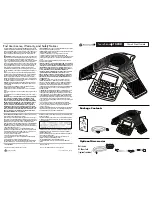
AEQ
PHOENIX STRATOS
44
-
CODEC LOOP TEST CH1: allows you to set up an encoded audio loop from the inputs
to the outputs of channel 1 of the unit (according to configuration in AUDIO SETTINGS,
ANALOG AUDIO SETTINGS and CHANNELS), to verify that it is operating correctly,
with applications in the maintenance of the unit or tests conducted before installing and
evaluating it.
-
CODEC LOOP TEST CH2: allows you to set up an encoded audio loop from the inputs
to the outputs of channel 2 of the unit (according to configuration in AUDIO SETTINGS,
ANALOG AUDIO SETTINGS and CHANNELS), to verify that it is operating correctly,
with applications in the maintenance of the unit or tests conducted before installing and
evaluating it.
-
HW VERSION: version identifier of the hardware platform on which the Phoenix
STRATOS unit in question is working. At the time this manual was being prepared, the
latest available version is V11.
-
BUZZER TEST: pressing the rotary encoder activates the ringing signal, to verify that it
is functioning properly.
-
LINEAR AUDIO LOOP CH1: allows you to set up a loop from the inputs to the outputs
of channel 1 (according to configuration in AUDIO SETTINGS, ANALOG AUDIO
SETTINGS and CHANNELS), with applications in the maintenance of the unit or tests
conducted before the unit is installed and evaluated. Similar to the CODEC LOOP
TEST feature, but with linear audio.
-
LINEAR AUDIO LOOP CH2: allows you to set up a loop from the inputs to the outputs
of channel 2 (according to configuration in AUDIO SETTINGS, ANALOG AUDIO
SETTINGS and CHANNELS), with applications in the maintenance of the unit or tests
conducted before the unit is installed and evaluated. Similar to the CODEC LOOP
TEST feature, but with linear audio.
-
SYSLOG SETTINGS: allows you to activate and configure the remote logs sending
function. You can activate/deactivate it, select the physical interface to send those and
the destination IP corresponding to a PC where the client SysLog application should be
installed. This option is used for high level debugging and technical support. By default,
this option is deactivated and it should not be activated unless AEQ’s Technical Service
requests for it.
-
SAVE SETTINGS: allows you to save the system configuration.
-
RESTORE SETTINGS: allows you to load the previously saved configuration.
-
DEFAULTS SETTINGS: allows you to load the default system configuration.
3.1.8. SETTINGS menu.
Menu for the local configuration of the unit, including Ethernet configuration. You can access the
SETTINGS menu from the SYSTEM MENU, in the eighth option, by pressing the rotary
encoder. This menu enables you to configure the following parameters.
3.1.8.1. Audible call notification.
The BUZZER submenu lets you activate/deactivate the incoming call notification buzzer.
3.1.8.2. Date and time.
The TIME & DATE submenu allows you to configure the time and date of the unit's local
system.
The procedure to configure the time in the Phoenix STRATOS codec is quite simple. Starting
from the default start screen, you can use the rotary encoder to select the modification of the
information associated with the time or the date. In both cases the lower line on the screen
represents actions associated with the contextual buttons.
















































